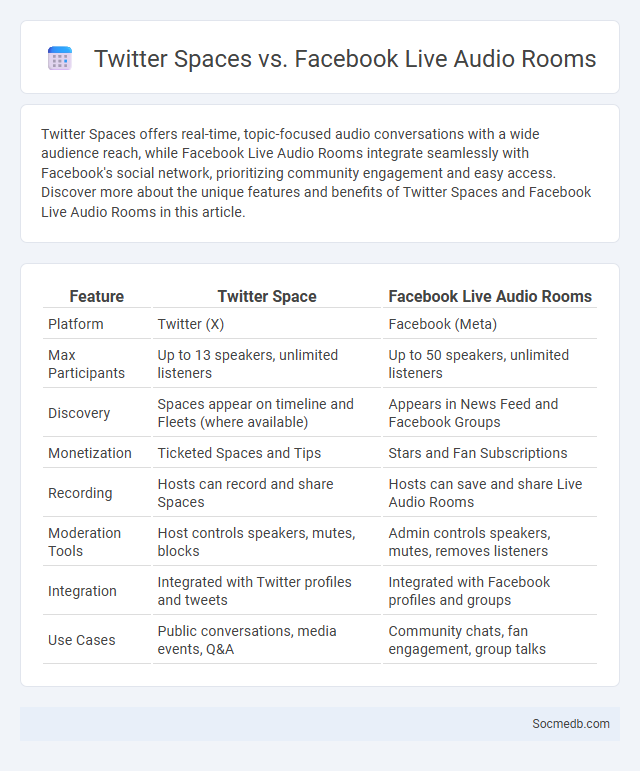
Photo illustration: Twitter Space vs Facebook Live Audio Rooms
Twitter Spaces offers real-time, topic-focused audio conversations with a wide audience reach, while Facebook Live Audio Rooms integrate seamlessly with Facebook's social network, prioritizing community engagement and easy access. Discover more about the unique features and benefits of Twitter Spaces and Facebook Live Audio Rooms in this article.
Table of Comparison
| Feature | Twitter Space | Facebook Live Audio Rooms |
|---|---|---|
| Platform | Twitter (X) | Facebook (Meta) |
| Max Participants | Up to 13 speakers, unlimited listeners | Up to 50 speakers, unlimited listeners |
| Discovery | Spaces appear on timeline and Fleets (where available) | Appears in News Feed and Facebook Groups |
| Monetization | Ticketed Spaces and Tips | Stars and Fan Subscriptions |
| Recording | Hosts can record and share Spaces | Hosts can save and share Live Audio Rooms |
| Moderation Tools | Host controls speakers, mutes, blocks | Admin controls speakers, mutes, removes listeners |
| Integration | Integrated with Twitter profiles and tweets | Integrated with Facebook profiles and groups |
| Use Cases | Public conversations, media events, Q&A | Community chats, fan engagement, group talks |
Introduction to Social Audio Platforms
Social audio platforms revolutionize online interaction by enabling real-time voice conversations, fostering genuine connections beyond text and images. These platforms leverage advanced algorithms to match users with relevant audio rooms and communities based on interests and social behaviors. Your engagement on social audio platforms enhances networking opportunities and provides new avenues for authentic content creation and discovery.
Overview of Twitter Spaces
Twitter Spaces is a live audio conversation feature integrated within the Twitter platform, enabling users to host and join real-time discussions. It supports interactive experiences by allowing speakers and listeners to engage through voice, fostering community building and networking. The feature is optimized for accessibility and reach, making it a powerful tool for brands, influencers, and users seeking dynamic social engagement.
Features of Facebook Live Audio Rooms
Facebook Live Audio Rooms enable real-time voice conversations, allowing you to engage with audiences through interactive discussions. Features include listener reactions, live comments, and the ability to invite guests to join the conversation seamlessly. These tools create immersive audio experiences that boost community interaction and content discoverability on the platform.
What is Space?
Space on social media refers to dedicated virtual rooms for real-time audio conversations, allowing users to host or join discussions with others using platforms like Twitter Spaces or Clubhouse. These interactive audio spaces facilitate networking, community building, and instant engagement without video or text, enhancing digital communication. The format supports live audience interaction through speaker requests, live reactions, and moderated discussions.
User Interface and Experience Comparison
User interface (UI) and user experience (UX) in social media platforms significantly influence user engagement and retention. Platforms like Instagram prioritize visually intuitive layouts and seamless navigation, enhancing user interaction through features like Stories and Reels, while Twitter emphasizes rapid content consumption with its timeline-centric design and real-time updates. Comprehensive comparison reveals that social media UI/UX effectiveness hinges on balancing visual appeal with functionality to cater to diverse user behaviors and preferences.
Audience Engagement and Interaction Tools
Social media platforms offer diverse audience engagement and interaction tools such as polls, live videos, and comment sections that foster meaningful connections between brands and users. These features enable real-time feedback, encourage user participation, and enhance content visibility by boosting algorithmic relevance. By leveraging these tools effectively, you can increase follower loyalty and drive higher engagement rates on your social media channels.
Monetization Opportunities
Social media platforms offer diverse monetization opportunities including sponsored content, affiliate marketing, and direct product sales, allowing creators and businesses to generate income effectively. Leveraging algorithms and audience insights maximizes engagement and revenue streams. Understanding these strategies empowers your brand to capitalize on social media's financial potential.
Privacy and Moderation Controls
Social media platforms implement advanced privacy settings allowing users to control data visibility, manage friend lists, and customize content sharing preferences. Robust moderation controls utilize artificial intelligence and human reviewers to detect and remove harmful content, such as misinformation, hate speech, and harassment, ensuring safer online environments. These combined privacy and moderation strategies enhance user trust and compliance with regulations like GDPR and CCPA.
Platform Accessibility and Reach
Social media platforms offer extensive accessibility across devices including smartphones, tablets, and desktops, enabling Your content to reach diverse audiences anytime and anywhere. Features such as multi-language support, customizable interfaces, and assistive technologies enhance user experience for individuals with disabilities. By leveraging platform accessibility, businesses and individuals can maximize reach, engagement, and inclusivity in their digital marketing strategies.
Which Platform is Best for Your Needs?
Choosing the best social media platform for your needs depends on your target audience, content type, and goals such as brand awareness, engagement, or sales. Instagram excels in visual storytelling and influencer marketing, while LinkedIn is ideal for B2B networking and professional content. You should analyze platform demographics, features, and analytics tools to maximize your social media strategy's effectiveness.
 socmedb.com
socmedb.com